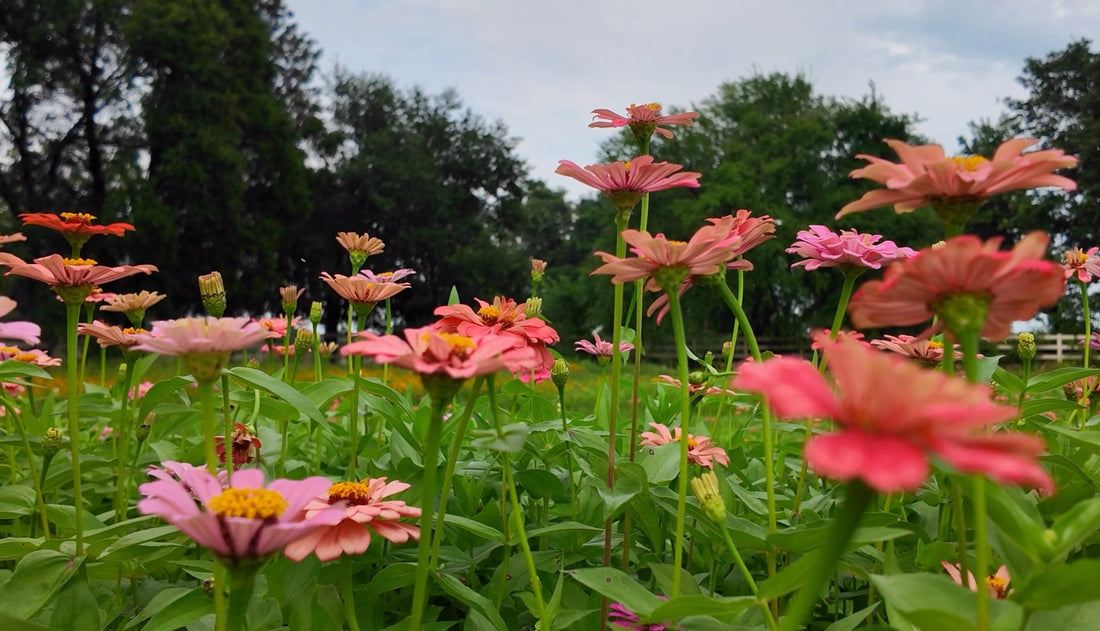
An Organic Method For Treating Powdery Mildew In Zinnias
Share
Powdery mildew is a common fungal disease that affects a variety of plants, including zinnias. This disease manifests as a white, powdery coating on the leaves, stems, and flowers, which can weaken the plant and reduce its aesthetic appeal. Fortunately, there's an effective and natural solution: a milk and water mixture. We use this method on farm for both blackspot and powdery mildew and it has been our chosen method for years. This blog post will guide you through preventing and treating powdery mildew on your zinnia plants using this simple method.
Understanding Powdery Mildew
Powdery mildew thrives in warm, dry environments and can spread quickly. It often appears as white or grayish powder on the upper surfaces of leaves. If left untreated, it can cause leaves to yellow, curl, or drop prematurely, and can severely impact the plant's overall health.
Why Milk?
Milk has been used for centuries as a natural fungicide. It contains proteins and other compounds that can help combat fungal growth. When applied to plants, milk can act as an antiseptic, killing fungal spores and preventing their spread. The exact mechanism isn't entirely understood, but it’s believed that the proteins in milk may interact with sunlight to create an environment that's hostile to fungi. The best part though is that it won’t harm our pollinator friends.
Preparing the Milk and Water Solution
Creating your own milk and water solution is simple and cost-effective. Here’s what you’ll need:
- Fresh milk (whole, skim, or powdered): Any type of milk will work, but whole milk is often preferred due to its higher fat content.
- Water: Clean, fresh water.
Mixing Instructions:
1. Combine milk and water in a ratio of 1:10. This means 1 part milk to 10 parts water. For example, if you’re using one cup of milk, mix it with 10 cups of water.
2. Stir well to ensure the milk is fully diluted in the water.
Application Instructions
1. Choose the right time: Apply the solution on a sunny day to maximize the efficacy. Sunlight helps enhance the antifungal properties of milk.
2. Use a spray bottle: Pour the milk and water solution into a clean spray bottle.
3. Thoroughly spray your zinnias: Ensure you cover all surfaces of the plant, including the undersides of the leaves, where powdery mildew often starts.
4. Repeat regularly: For prevention, spray your plants once every 7-10 days. If treating an existing infection, apply the solution every 3-4 days until the mildew subsides.
Additional Tips for Managing Powdery Mildew
- Improve air circulation: Powdery mildew thrives in crowded conditions. Space your zinnia plants adequately and prune any overcrowded areas.
- Water early in the day: This allows the plants to dry before nightfall, reducing the likelihood of fungal growth.
- Remove affected leaves: If you notice leaves heavily covered in mildew, remove and dispose of them to prevent further spread.
Conclusion
Using a milk and water solution is a natural, effective way to prevent and treat powdery mildew on zinnia plants. Regular application, combined with good gardening practices, can keep your zinnias healthy and thriving. Embrace this simple, eco-friendly method to enjoy vibrant and mildew-free zinnias all season long.

Moody Mix Zinnia

2 comments
Thank you for this tip! I just sprayed my Zinnas!
Thank you for this tip! I just sprayed my Zinnas!